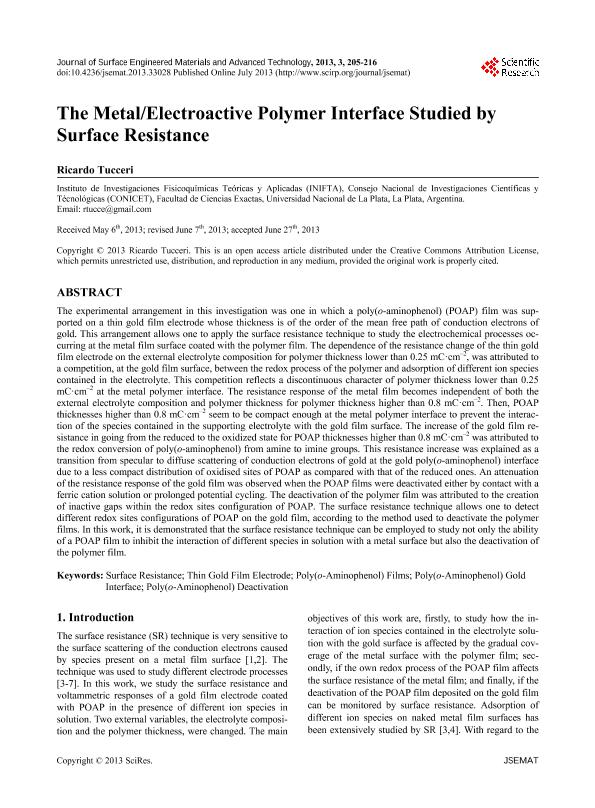Mostrar el registro sencillo del ítem
dc.contributor.author
Tucceri, Ismael Ricardo

dc.date.available
2016-04-11T19:45:34Z
dc.date.issued
2013-07
dc.identifier.citation
Tucceri, Ismael Ricardo; The metal/electroactive polymer interface studied by surface resistance; Scientific Research; Journal of Surface Engineered Materials and Advanced Technology; 3; 3; 7-2013; 205-216
dc.identifier.issn
2161-4881
dc.identifier.uri
http://hdl.handle.net/11336/5126
dc.description.abstract
The experimental arrangement in this investigation was one in which a poly(o-aminophenol) (POAP) film was sup- ported on a thin gold film electrode whose thickness is of the order of the mean free path of conduction electrons of gold. This arrangement allows one to apply the surface resistance technique to study the electrochemical processes oc- curring at the metal film surface coated with the polymer film. The dependence of the resistance change of the thin gold film electrode on the external electrolyte composition for polymer thickness lower than 0.25 mC·cm–2, was attributed to a competition, at the gold film surface, between the redox process of the polymer and adsorption of different ion species contained in the electrolyte. This competition reflects a discontinuous character of polymer thickness lower than 0.25 mC·cm–2 at the metal polymer interface. The resistance response of the metal film becomes independent of both the external electrolyte composition and polymer thickness for polymer thickness higher than 0.8 mC·cm–2. Then, POAP thicknesses higher than 0.8 mC·cm–2 seem to be compact enough at the metal polymer interface to prevent the interac- tion of the species contained in the supporting electrolyte with the gold film surface. The increase of the gold film re- sistance in going from the reduced to the oxidized state for POAP thicknesses higher than 0.8 mC·cm–2 was attributed to the redox conversion of poly(o-aminophenol) from amine to imine groups. This resistance increase was explained as a transition from specular to diffuse scattering of conduction electrons of gold at the gold poly(o-aminophenol) interface due to a less compact distribution of oxidised sites of POAP as compared with that of the reduced ones. An attenuation of the resistance response of the gold film was observed when the POAP films were deactivated either by contact with a ferric cation solution or prolonged potential cycling. The deactivation of the polymer film was attributed to the creation of inactive gaps within the redox sites configuration of POAP. The surface resistance technique allows one to detect different redox sites configurations of POAP on the gold film, according to the method used to deactivate the polymer films. In this work, it is demonstrated that the surface resistance technique can be employed to study not only the ability of a POAP film to inhibit the interaction of different species in solution with a metal surface but also the deactivation of the polymer film.
dc.format
application/pdf
dc.language.iso
eng
dc.publisher
Scientific Research
dc.rights
info:eu-repo/semantics/openAccess
dc.rights.uri
https://creativecommons.org/licenses/by/2.5/ar/
dc.subject
Surface Resistance
dc.subject
Thin Gold Film Electrode
dc.subject
Oly(O-Aminophenol) Films
dc.subject
Poly(O-Aminophenol)/Gold Interface
dc.subject.classification
Físico-Química, Ciencia de los Polímeros, Electroquímica

dc.subject.classification
Ciencias Químicas

dc.subject.classification
CIENCIAS NATURALES Y EXACTAS

dc.title
The metal/electroactive polymer interface studied by surface resistance
dc.type
info:eu-repo/semantics/article
dc.type
info:ar-repo/semantics/artículo
dc.type
info:eu-repo/semantics/publishedVersion
dc.date.updated
2016-05-06 15:52:43.262787-03
dc.journal.volume
3
dc.journal.number
3
dc.journal.pagination
205-216
dc.journal.pais
Estados Unidos

dc.journal.ciudad
Irvine
dc.description.fil
Fil: Tucceri, Ismael Ricardo. Consejo Nacional de Investigaciones Científicas y Técnicas. Centro Científico Tecnológico la Plata. Instituto de Investigaciones Fisicoquímicas Teóricas y Aplicadas; Argentina. Universidad Nacional de La Plata; Argentina
dc.journal.title
Journal of Surface Engineered Materials and Advanced Technology
dc.relation.alternativeid
info:eu-repo/semantics/altIdentifier/doi/10.4236/jsemat.2013.33028
dc.relation.alternativeid
info:eu-repo/semantics/altIdentifier/url/http://www.scirp.org/journal/PaperInformation.aspx?PaperID=34482
dc.relation.alternativeid
info:eu-repo/semantics/altIdentifier/doi/http://dx.doi.org/10.4236/jsemat.2013.33028
Archivos asociados
